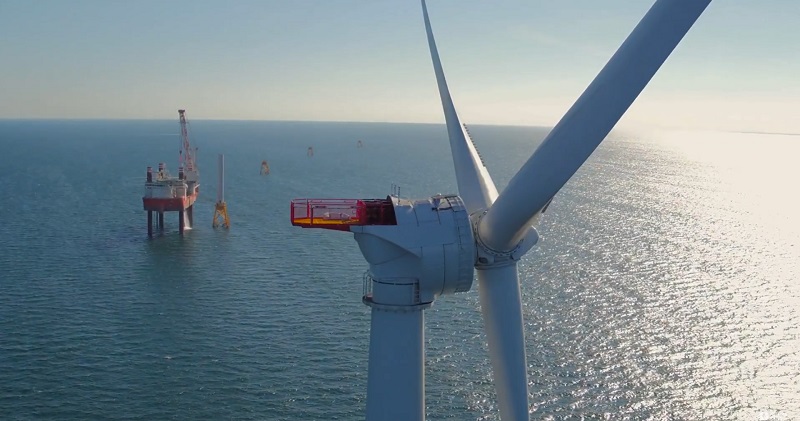What do the Eastern Seaboard states of New York, Massachusetts, Connecticut, New Jersey, Maryland, and Virginia all have in common? Each has committed to developing offshore wind generation to a targeted level by a date certain.
It's time for North Carolina to do the same. North Carolina has repeatedly been recognized as having exceptional potential for offshore wind generation. A commitment to a specific goal for that development would build on the intent of Gov. Roy Cooper's 2018 Executive Order 80, which established the state's Clean Energy Plan.
The six states to our north have made these pledges, which would amount to a total of 25,400 MW from offshore wind power by 2026-2035:
- New York: New York Gov. Andrew Cuomo announced a 2,400 MW commitment for offshore wind by 2030. In 2019, he increased the target to 9,000 MW of offshore wind by 2035.
- New Jersey: In November 2019, New Jersey Gov. Phil Murphy issued an executive order for an offshore wind target of 7,500 MW by 2035. New Jersey has had two offshore wind solicitations: The first was awarded to Ørsted for a 1,100 MW project and the second lease area was opened in September 2020 with potential for a committed capacity of 3,500 MW.
- Virginia: Virginia Gov. Ralph Northam issued an executive order in September 2019 for 2,500 MW of offshore wind by 2026. In March 2020, the Virginia General Assembly passed a law including an offshore wind target of 5,200 MW by 2034 for Dominion Energy. Two projects are moving ahead: Dominion Energy and Ørsted finished construction of the 12 MW Coastal Virginia Offshore Wind Project in June 2020 and, in September 2019, Dominion Energy announced plans to build a 2,640 MW offshore project by 2026.
- Massachusetts: Massachusetts has one of the longest histories of any state in offshore wind. In 2016, the state passed a law targeting development of 1,600 MW of offshore wind by 2027. It followed up with a law authorizing the utilities to procure an additional 1,600 MW by 2035 (for a total of 3,200 MW by 2035). Massachusetts lawmakers recently increased the offshore wind goal to 5,600 MW. Two projects have been announced or constructed: In May 2018, Massachusetts utilities selected the 800 MW Vineyard Wind project as the winner of its first offshore wind request for proposals (RFP). Massachusetts issued its second offshore wind RFP in May 2019, and in October awarded the project to the 804 MW Mayflower Wind project.
- Maryland: Maryland completed the first large-scale solicitation of offshore wind in the U.S. in May 2017 for two projects totaling 368 MW. In May 2019, Maryland passed an offshore wind mandate for an additional 1,200 MW by 2030 and followed up with its second offshore wind solicitation in March 2020.
- Maine: Gov. Janet Mills announced the Maine Offshore Wind Initiative in 2019, including the approval of a contract for a 12 MW New England Aqua Ventus floating demonstration project.
 There is no reason that North Carolina can't do what these other states have done. As we noted above, North Carolina has better offshore wind potential than any other state along the eastern seaboard. The Bureau of Ocean Energy Management (BOEM) has identified several areas off our coast that are particularly suited for offshore wind facilities: Kitty Hawk, Wilmington-West, and Wilmington-East. The National Renewable Energy Laboratory (NREL) map shows mean annual wind speeds at 7 meters per second and greater than a 90 meters high within 50 miles of the North Carolina coast.
There is no reason that North Carolina can't do what these other states have done. As we noted above, North Carolina has better offshore wind potential than any other state along the eastern seaboard. The Bureau of Ocean Energy Management (BOEM) has identified several areas off our coast that are particularly suited for offshore wind facilities: Kitty Hawk, Wilmington-West, and Wilmington-East. The National Renewable Energy Laboratory (NREL) map shows mean annual wind speeds at 7 meters per second and greater than a 90 meters high within 50 miles of the North Carolina coast.
Currently, the Kitty Hawk Offshore Wind project is the only offshore wind project being developed off the coast of North Carolina, and it is expected to generate 2,500 MW when it is completed - enough to power 700,000 homes. The project developer, Avangrid Renewables, estimates nearly $2 billion in total economic impact over the next decade in Virginia and northeast North Carolina.
North Carolina's state government is near completion of an offshore wind study that is meant to show how the state's workers and businesses can benefit from participating in the industry. The study is intended to determine how to grow the offshore wind supply chain (development, construction, operation, and maintenance) and infrastructure (turbine, generators, foundations, and other component parts), while ensuring that the appropriate workforce is in place.
Duke Energy has also expressed interest; its integrated resource plan (IRP), which makes out different scenarios to reach 70 percent carbon reductions by 2030, includes one scenario with 5,500 MW of onshore and offshore wind.
Right now, the only operational offshore wind project in the United States is the five-turbine Block Island Wind Farm off the coast of Rhode Island (pictured). But opportunities are opening for the industry, with President Biden expected to throw his support behind it.
It is time for Governor Cooper to do the same in a tangible way by announcing an offshore wind target for North Carolina, letting offshore wind developers and investors know that the state not only wants their business, but will rely on it as we build our clean energy future.